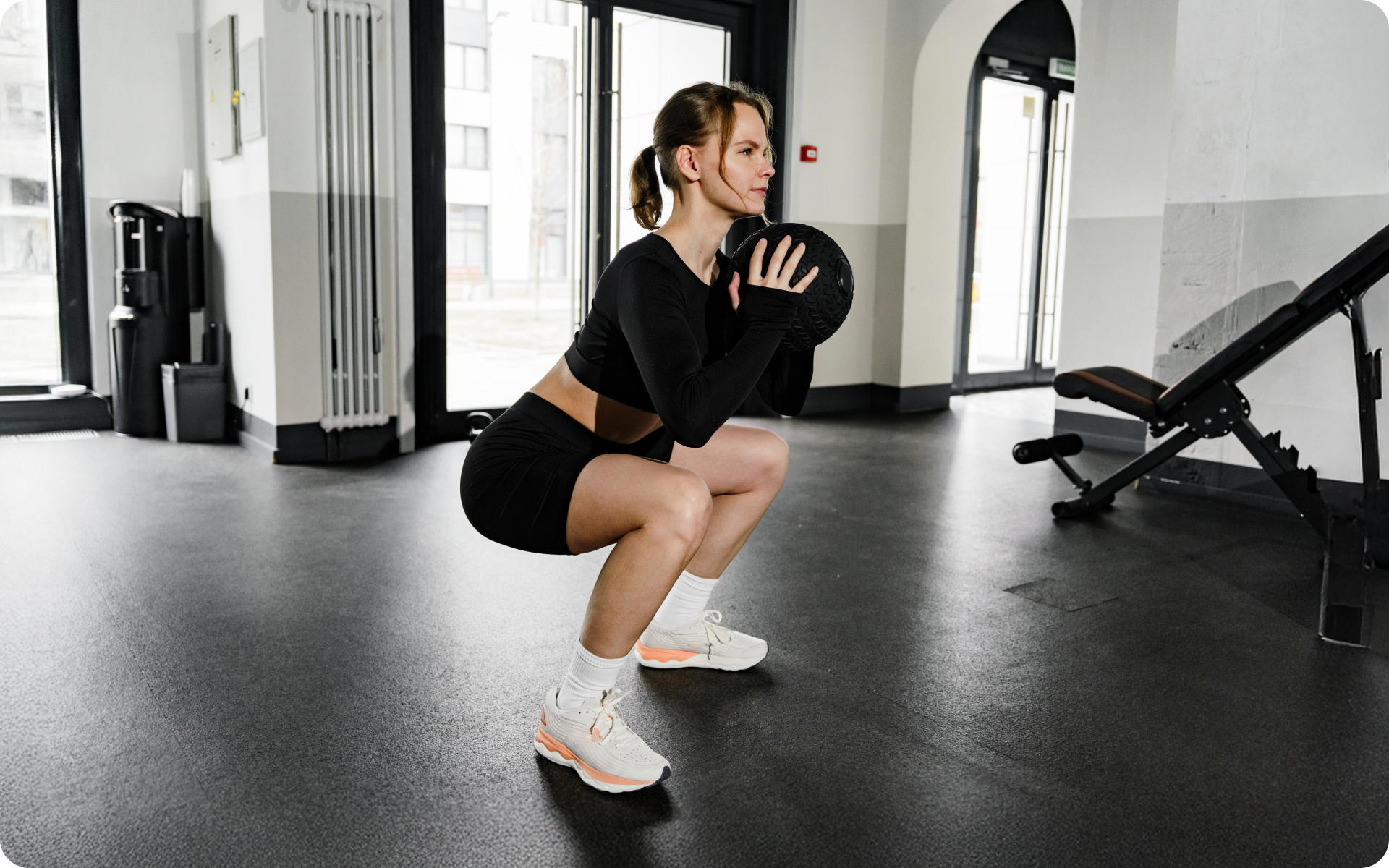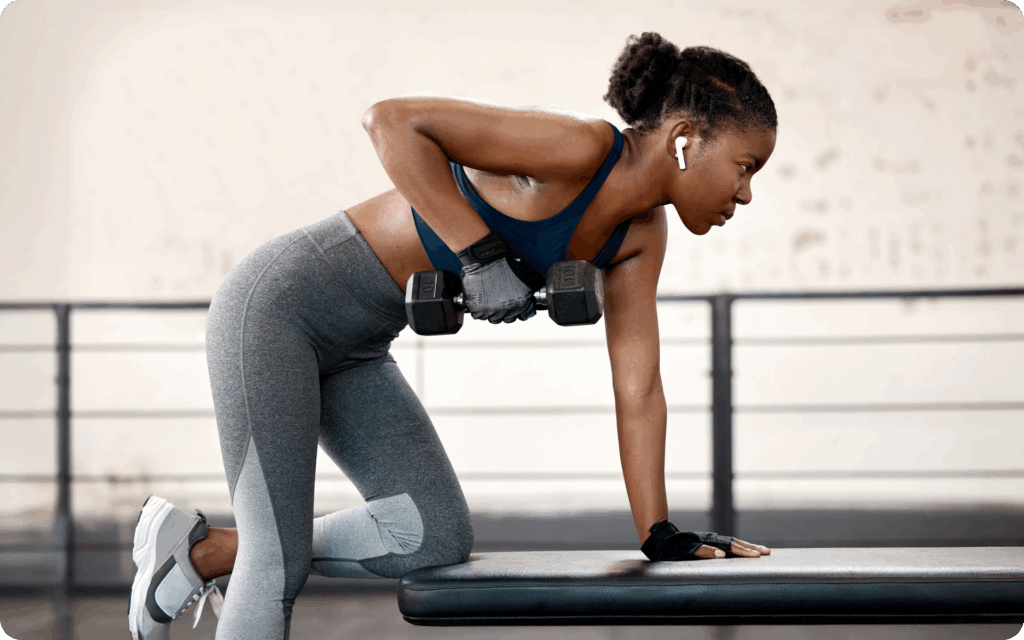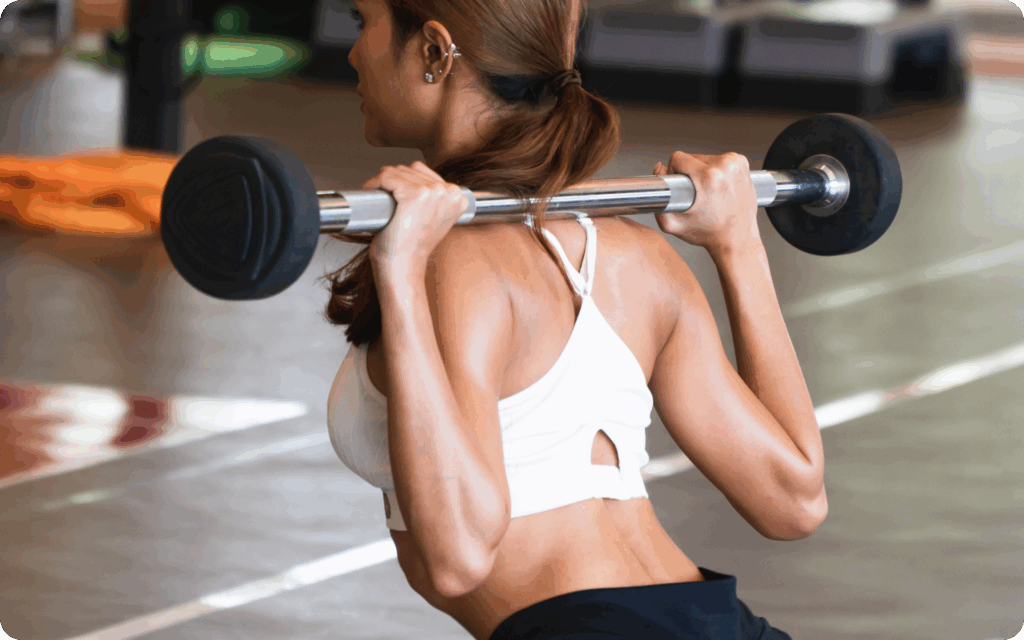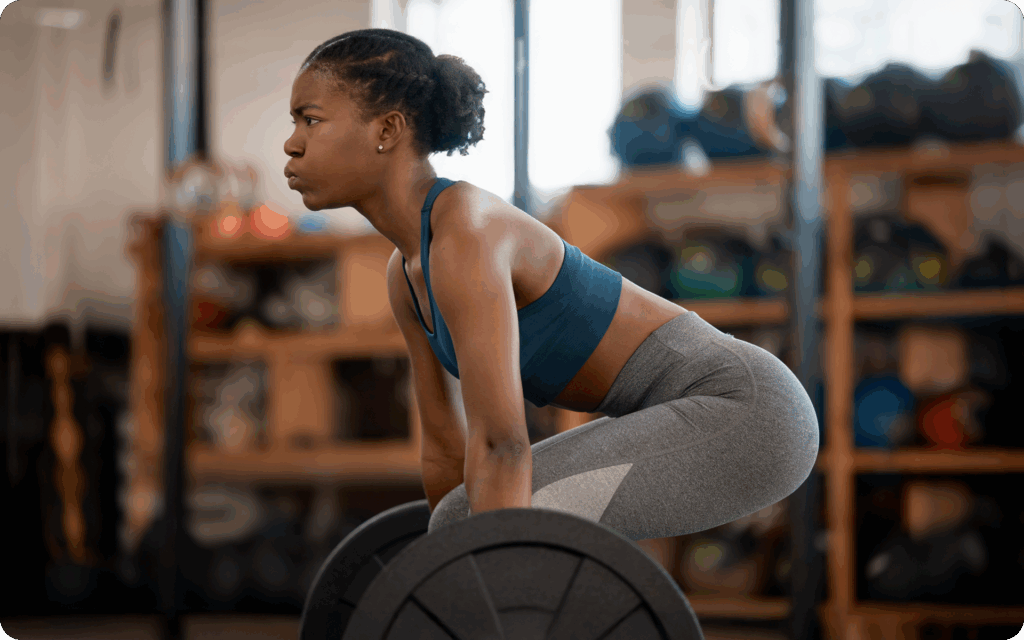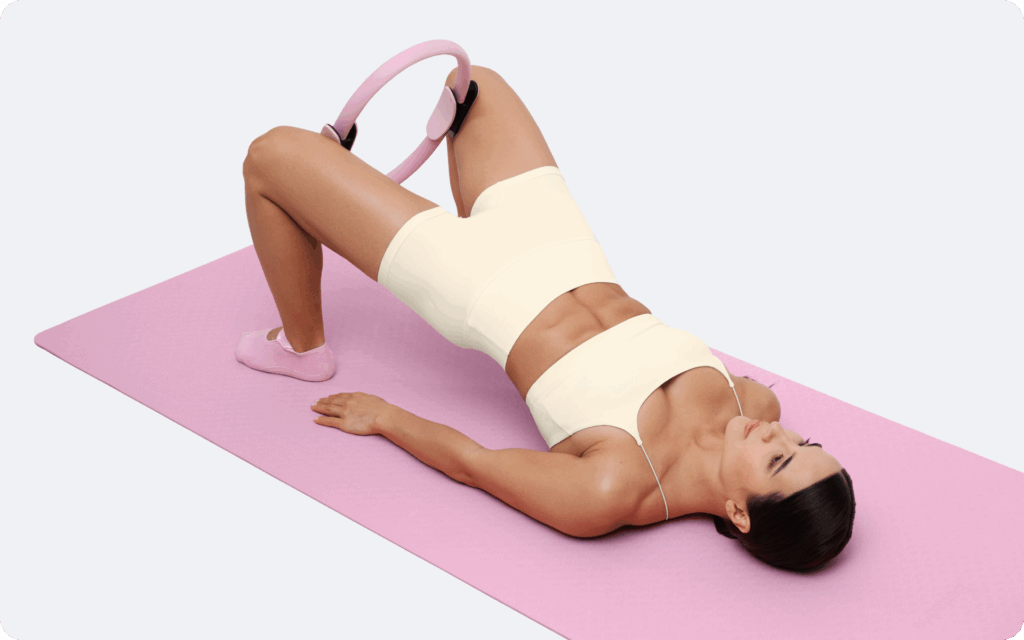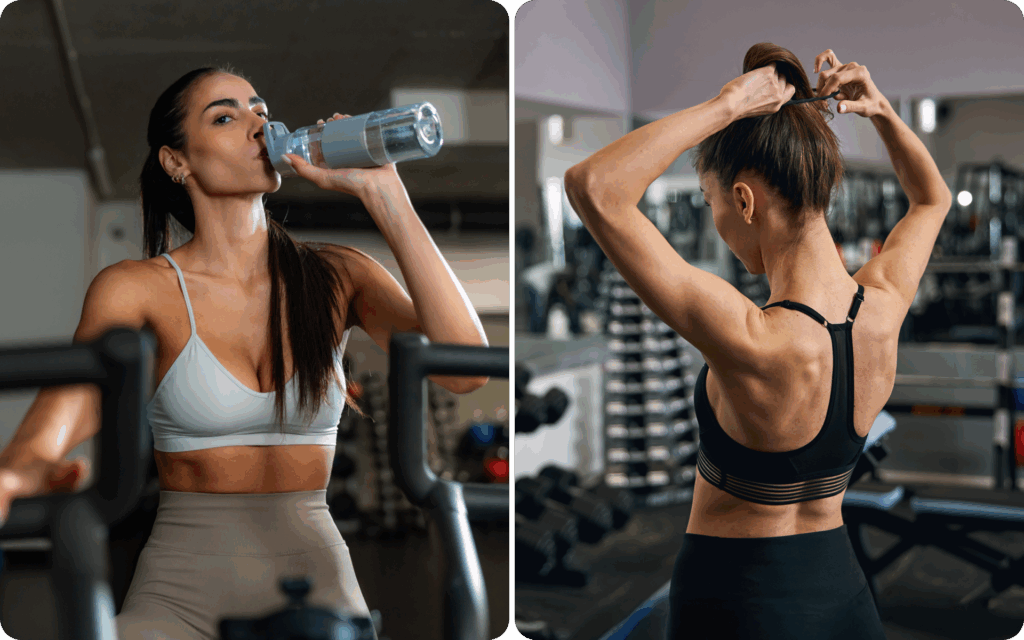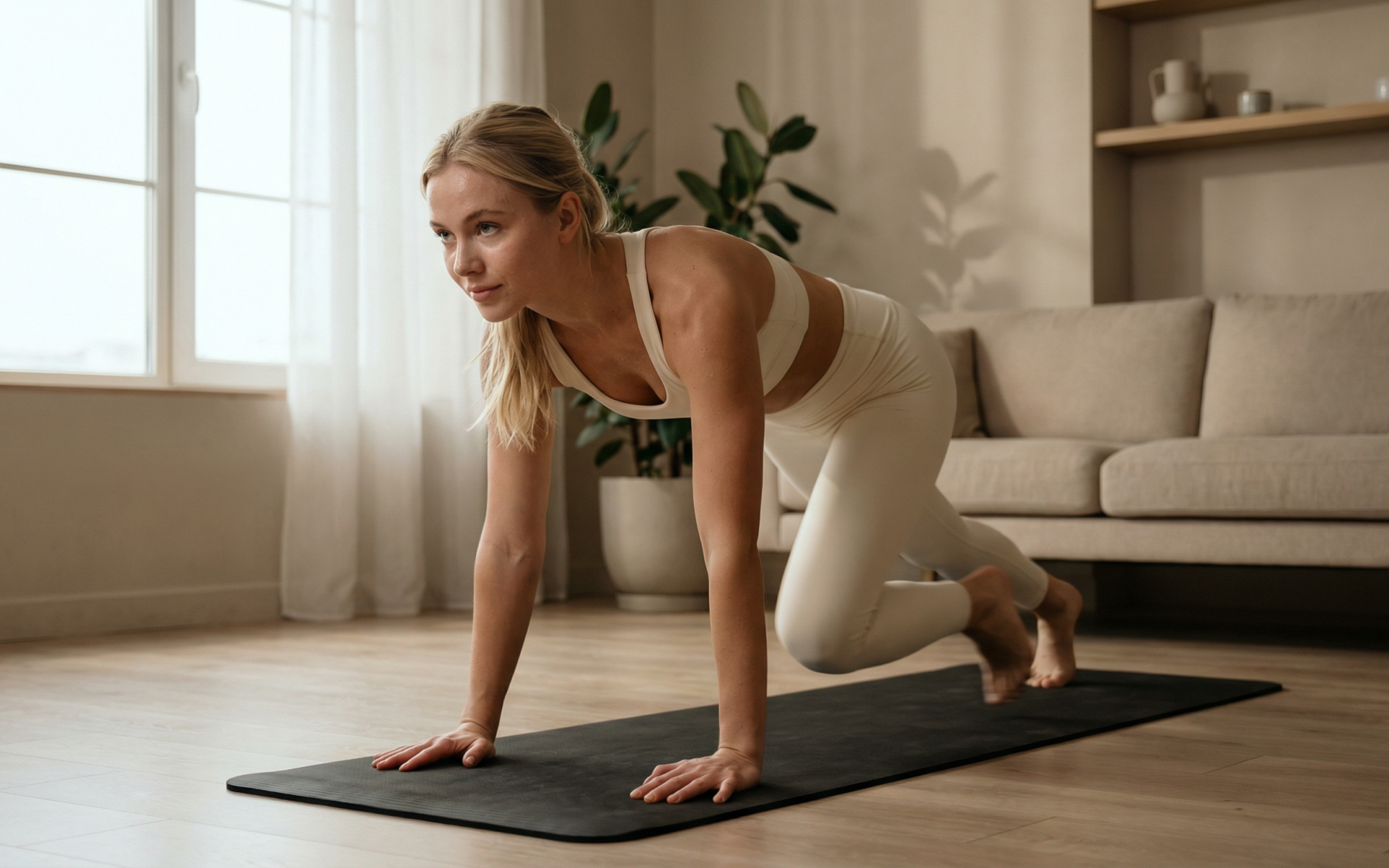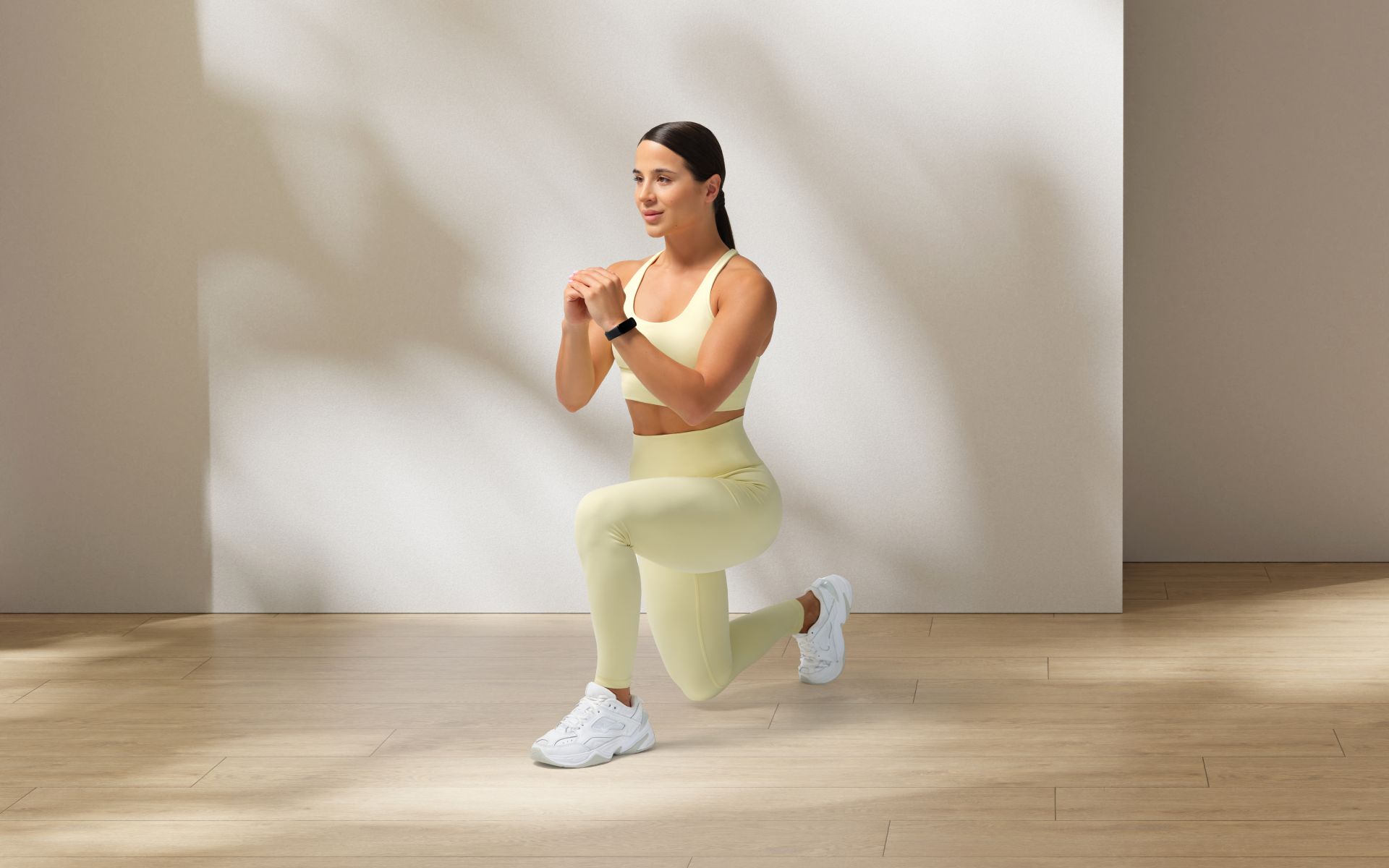Let’s be real – most of us don’t have hours to spend at the gym. Between work, family, and the occasional attempt at a social life, workouts often feel like one more thing on the to-do list. That’s where the superset workout plan comes in, not just as a time-saver, but as a seriously effective way to shake up your training and actually feel like you’re making progress.
So what is it, exactly? A superset is when you pair two exercises together and perform them one after the other, with little to no rest in between (1). It’s a proven method of training that maximizes time efficiency, often cutting training time by 25-50%. However, it can still provide the same strength and hypertrophy benefits if performed correctly.
But this isn’t some one-size-fits-all trend. Whether you’re brand new to strength training or someone who’s been lifting for years, the beauty of a superset workout plan is that it can be tailored to suit your goals, your fitness level, and your lifestyle.
In our article today, we’re diving into the science and strategy behind supersets: how they work, what they do, and why they may just be the secret weapon your workout routine has been missing.
What Is an Intense Superset Workout Plan?
Picture this: you finish your final dumbbell press, take a breath (barely), and immediately drop to the mat for a set of push-ups. No scrolling through your playlist, no glancing at the clock, just back-to-back movement that makes your muscles really pay attention.
That’s the heart of a superset workout plan, and when you dial up the effort, it transforms into something a little more intense, a little more effective, and a lot more sweat-inducing.
At its core, a superset is a workout strategy where you do two exercises in a row with little to no rest in between. There are generally two ways to get this done:
- “Antagonist” superset – Exercises can target opposing muscles – think biceps followed by triceps).
- “Agonist” superset – Exercises target the same muscle group – perform the bench press followed by dumbbell flyes. These are also known as “compound sets”(2).
The idea is to maximize efficiency in the gym, allowing yourself to increase total workload in half the time. This is what makes it so efficient.
BetterMe: Health Coaching app helps you achieve your body goals with ease and efficiency by helping to choose proper meal plans and effective workouts. Start using our app and you will see good results in a short time.
Now, what makes a superset workout intense? It’s not just about doing two moves back to back. It’s about the details:
- Minimal rest – can vary, but usually just enough to provide a bit of rest.
- Compound movements that involve multiple joints and muscle groups (3).
- Controlled tempo to challenge your form and endurance (4).
- Deliberate muscle pairings that increase workload and intensity without compromising form (5).
An intense superset workout plan is built for efficiency. It allows you to get more work done in less time, while also sneaking in some light cardio because of the faster pace. It’s often used by people who want results, but don’t want to spend 90 minutes lifting weights.
What’s also worth noting: you don’t have to be an advanced athlete to try it. Intensity is relative. What’s “intense” for one person might be a warm-up for another and that’s completely fine. The goal isn’t to break yourself down. It’s to build a routine that challenges you, keeps you engaged, and fits your energy level.
So whether you’re someone who thrives on fast-paced circuits or someone who just wants to stop wasting time between sets, an intense superset workout plan could be the shake-up your fitness routine’s been craving.
Read more: Lower-Body Gym Workout for Female Beginners: Complete Guide
Do Supersets Burn More Fat?
The short answer? Yes, at least compared to traditional resistance training with rest between sets, but the difference is about efficiency.
A superset workout plan isn’t just about building strength, it’s also a sneaky little metabolic booster (5). It’s about keeping your body moving, your heart rate up, and your energy demand high. When you perform exercises back to back without rest, your muscles and cardiovascular system have to work harder in a shorter amount of time. That added intensity can slightly increase calorie burn during the session.
In one study published in the Journal of Strength and Conditioning Research, participants performing reciprocal supersets (such as pairing a bench press with a row) burned more calories per minute and showed higher heart rates than those following traditional rest‑based training. However, total calorie burn across the entire workout was similar. The difference came from completing the same volume in less time (6).
Why Supersets Support Fat Burn:
- Elevated heart rate: Less rest means your heart is constantly working, mimicking a light cardio session (5).
- Burn calories in less time: You’re doing double the work without doubling your workout length(5).
- Afterburn effect (EPOC): Your body continues burning calories even after you’re done, especially after intense superset sessions (7). However, this effect is temporary and modest – it won’t dramatically change long‑term fat loss on its own.
- Better use of compound movements: Supersets often involve big, functional exercises such as squats, presses, and rows that recruit more muscle and burn more energy(3).
So, while a superset workout plan for weight loss can help you burn slightly more calories and make workouts more time‑efficient, it’s not a fat‑loss shortcut. The real payoff comes from the combination of intensity, consistency, and smart recovery, not just the afterburn.
Are Supersets Good to Build Muscle?
If you’ve ever wondered whether a superset workout plan can help you build strength and size, the answer is yes, but under the right conditions. While supersets are often praised for saving time, they can also support muscle growth and even strength development, especially when programmed intentionally.
Recent research has supported this. A 2024 study published in the Journal of Strength and Conditioning Research found that performing agonist supersets, i.e. two exercises for the same muscle group, led to similar increases in strength and hypertrophy compared to traditional sets over a 9-week program, but in significantly less time (8).
Another recent meta-analysis also concluded that superset-style training, particularly antagonist supersets, can be just as effective as traditional strength training for developing muscle and strength, with no clear disadvantages in well-structured programs (9).
Now, the type of superset matters. If you’re looking to build muscle and strength, consider using:
- Antagonist supersets: These pair opposing muscle groups – such as biceps and triceps. While one works, the other rests, which makes your sessions more time-efficient without sacrificing output. These are ideal if strength is your priority, as they help maintain load while reducing rest time.
Example:
Bicep curl → Tricep dip
- Agonist supersets: Pair exercises that target the same muscle group, such as a bench press followed by a chest fly. This method floods the muscle with blood and maximizes fatigue, which can lead to muscle growth over time. These would typically be used when muscle growth is the primary goal.
- Example:
Bench press → Chest fly - Pre-exhaustion supersets: This strategy starts with an isolation movement to tire out a specific muscle, followed by a compound lift. It can increase perceived effort and help recruit more muscle fibers during the compound lift (8).
Example:
Leg extensions → Barbell squats
And don’t worry, you don’t need to be lifting the heaviest weights in the gym to see gains. Volume, control, and consistency matter more. Just keep in mind that progressive overload still rules. Supersets aren’t a shortcut – they’re just another tool in your training toolbox. If you’re increasing volume over time, recovering well, and tracking progress, a superset workout plan can absolutely build muscle and strength.
In short, yes, supersets can absolutely help build muscle. You just need to be intentional about your pairings, lift with good form, and allow enough recovery between sessions. It’s less about lifting heavier and more about training smarter.
Should I train to failure every set when doing supersets?
Also, a quick note on a common question: should I train to failure every set when doing supersets? Not necessarily. While occasionally pushing a set to failure can help break through a plateau, doing it too often, particularly in a superset format, can lead to poor form, joint strain, and burnout (10). Save failure for your final set or for lighter isolation movements where the risk is lower.
How to Plan a Superset Workout
Designing a superset workout plan doesn’t need to be complicated, but it does need to be intentional. The right plan depends on two things: your goal and how many days a week you can realistically train.
Supersets can be structured for a variety of goals such as fat loss, strength, muscle growth, or time-efficiency, but it’s your consistency that matters most. And while supersets are great for saving time, their effectiveness still depends on smart programming.
Whether you’re a workout beast or just a beginner making your first foray into the world of fitness and dieting – BetterMe has a lot to offer to both newbies and experts! Install the app and experience the versatility first-hand!
Step-by-Step Guide to Structuring Your Superset Plan
1. Pick your goal
Here’s how to align your superset style with your primary goal:
- Fat loss: Use compound movement supersets that train your entire body. For example, pair goblet squats with push-ups. These keep your heart rate elevated and work large muscle groups simultaneously, which increases energy expenditure.
- Muscle growth (hypertrophy): Use agonist or antagonist supersets (more on that below) with moderate weights and controlled tempo. Focus on muscle fatigue and form.
- Strength: Stick with antagonist supersets and take longer rest periods. This helps you maintain your performance without compromising load.
2. Choose your superset format
Each format offers a different benefit. Choose based on your fitness level, time availability, and training frequency:
- Antagonist supersets (ideal 3-5x/week): Pair opposing muscle groups such as chest and back or biceps and triceps. This allows one muscle group to recover while the other works, which helps maintain lifting quality with reduced workout time.
- Example: Dumbbell bench press + bent-over row
- Upper-lower supersets (ideal 2-4x/week): Pair a lower-body move with an upper-body one. This is time-efficient and works well for full-body training without overloading one area.
- Example: Goblet squat + shoulder press
- Same-muscle group (agonist) supersets (ideal 2-3x/week): These are more intense and best used sparingly. They target the same muscle group twice in a row, increasing fatigue and time under tension.
- Example: Lat pulldown + straight-arm pulldown
If you’re training 2-3 days per week, prioritize full-body antagonist or upper-lower supersets. If you train 4-5 days per week, you can split your workouts by muscle group and rotate in agonist supersets more often.

For most people:
- 4 to 6 supersets per session (8 to 12 total exercises)
- 2 to 4 rounds of each superset (depending on time and intensity)
- 8 to 12 reps per exercise is a reliable sweet spot for both strength and muscle building.
4. Set your rest times
- Between the two exercises in a superset: Keep rest very short, about 10 to 20 seconds – just enough time to transition.
- After completing the superset pair: Rest for 45 to 90 seconds, depending on your goal. Shorter rest (45 seconds) works well for fat loss, while longer rest (up to 90 seconds) helps maintain strength output.
Note: If you’re training with heavier weights or prioritizing strength, err on the longer side of recovery between rounds.
Tips for First-Timers
Getting started with supersets? Here’s how to make it work for you without burning out or getting overwhelmed.
- Start with machines or light dumbbells: Contrary to popular belief, bodyweight exercises can be very advanced. Machines or adjustable weights allow you to control the load and build confidence in your form. For example, a lat pulldown is often more beginner-friendly than chin-ups.
- Use “simple” movement patterns: This means exercises that involve fewer joints or have a lower risk of technical breakdown.
- Example of a simple move: Leg press
- Example of a more technical move: Barbell snatch
- Avoid pairing two highly technical moves together: Combining front squats and overhead presses may be too demanding for a beginner. Instead, pair something technical with something more controlled.
- Better pairing: Goblet squat + bicep curl
- Don’t skip rest entirely: Supersets are meant to save time, but recovery still matters. Take enough rest to maintain your form and don’t just push through sloppily for the sake of speed.
Supersets are a powerful tool. They condense time, boost training volume, and keep workouts engaging. But the magic isn’t in doing more. It’s in doing just enough, done well.
What Are Examples of a Superset Workout Plan?
Now that you know how to build your own superset workout plan, let’s get practical. Below are real-world examples you can try, whether you’re a beginner who is easing into movement, someone who is ready to sculpt with purpose, or a full-body warrior who is looking for that post-workout burn.
Beginner-Friendly Superset Workout
This is perfect if you’re new to strength training or returning after a break. It keeps things simple, with a mix of bodyweight and low-impact moves.
- Superset 1
Squats (12 reps)
Glute bridges (12 reps) - Superset 2
Wall push-ups (10 reps)
Dumbbell rows or backpack rows (10 reps per arm) - Superset 3
Seated knee raises (15 reps)
Bird-dogs (10 reps per side)
Rest for 30 to 45 seconds between each superset. Perform 2 to 3 rounds total.
Chest Superset Workout
This one’s a focused burner – great for building upper-body strength and toning.
- Superset 1
Push-ups (standard or incline) – 10 to 12 reps
Chest flys with dumbbells – 10 reps - Superset 2
Incline Dumbbell Press – 8 to 10 reps
Wide-arm chest press – 10 reps
Our previous post goes into great detail about the chest superset workout.
Calisthenics Supersets
No equipment? No problem. Calisthenics supersets use bodyweight-only movements to build strength, mobility, and balance.
- Superset 1
Jump squats (12 reps)
Pike push-ups (10 reps) - Superset 2
Reverse lunges (10 reps per leg)
Plank shoulder taps (30 seconds)
This is great for when you’re training outdoors, traveling, or just skipping the gym.
Superset Workout Full Body
This one covers all the major muscle groups and keeps your heart rate up.
- Superset 1
Dumbbell squats – 12 reps
Shoulder press – 10 reps - Superset 2
Bent-over rows – 12 reps
Glute bridges – 15 reps - Superset 3
Bench press – 30 seconds
Plank – 30 seconds
This is your go-to when you want a quick, efficient session that hits everything.
Sample 7-Day Superset Workout Plan
This layout is for reference – you don’t need to train hard every single day. The key is alternating intensity with recovery.
- Day 1: Upper-body supersets
- Day 2: Lower-body supersets
- Day 3: Rest or yoga
- Day 4: Full-body superset workout
- Day 5: Cardio or walking
- Day 6: Calisthenics supersets
- Day 7: Rest
You can mix and match based on your lifestyle. Your body doesn’t need punishment, it needs a plan it can stick to.
Read more: Full-Body Calisthenics Workout Plan For Beginners (Complete Guide)
How Many Times a Week Should I Do Supersets?
If you’ve ever done a proper superset workout plan, you already know – it doesn’t mess around. The burn is real, the sweat is instant, and by the end of round three, your muscles are talking back. So it’s a fair question: how often should you actually be doing this kind of training?
The sweet spot? 2 to 4 times a week
For most people, especially those juggling work, stress, and maybe not-so-perfect sleep, 2 to 4 superset-focused sessions each week is more than enough (3). This allows you to get strong, stay consistent, and still give your body time to recover.
Here’s a basic guide based on your current fitness level:
- Beginners:
Start with 2 sessions per week. Focus on full-body supersets and leave a day in between for recovery. You’re teaching your body a new rhythm – give it time to adjust. - Intermediate:
Aim for 3 to 4 superset days per week, mixing upper-body, lower-body, and full-body combinations. This allows for intensity without burnout. - Advanced:
You can do up to 5 sessions a week if you’re managing your recovery well. Just be mindful of overtraining signs such as poor sleep, extreme soreness, or lack of motivation.
And no, you don’t have to feel sore every time to know it’s working. Soreness isn’t a badge of honor – it’s just one signal out of many. If your performance is improving, your form is solid, and you’re recovering well, you’re doing it right.
What Are the Disadvantages of Supersets?
Let’s be clear. There’s a lot to love about a superset workout plan. However, as with any fitness method, it’s not perfect for every person in every situation. Knowing the downsides can help you train smarter, avoid setbacks, and get the most out of your sessions.
Potential Drawbacks to Keep in Mind:
- Form can slip when fatigue sets in
One of the biggest risks with supersets is rushing through reps just to survive the second exercise. Without rest, your form can break down, particularly in compound movements. This opens the door to aches, pains, or even injury if you’re not careful (11). - Not ideal for lifting really heavy
If your goal is maximum strength, like heavy deadlifts or bench presses, supersets may not give you enough recovery time between sets to safely lift at that intensity. For those moments, traditional training is more effective (12). - Can be overwhelming for absolute beginners
Jumping straight into high-intensity supersets when you’re still learning basic movement patterns can feel like a crash course with no seatbelt. Many bodyweight movements, such as push-ups or tricep dips, are actually quite advanced for true beginners. This is why it’s better to start a superset workout plan for beginners that uses machines, cables, or light dumbbells. These allow you to control load and master form before progressing to more complex or bodyweight-based exercises. Slow, structured progression always beats rushing into volume or intensity, and slow progression is so important. - May interfere with recovery if overused
Supersets are effective yet can be more intense than traditional training. This means there’s a possibility for them to cause greater stress on the body, meaning there’s a possibility they’ll need greater recovery time.
So what’s the takeaway? Supersets are a tool, not a rule. They’re fantastic when used wisely, in a way that matches your current fitness level, goals, and energy. As always, quality beats quantity.
Yes, supersets work well with opposing muscle groups such as biceps and triceps. This pairing allows one muscle to rest while the other works, which helps you train efficiently without losing intensity. Both are effective depending on your goals, but supersets are primarily useful for saving time. If you’re short on time, they’re highly efficient. However, if your goal is to maximize strength with heavier loads and longer rest, straight sets are the better choice. Ultimately, both training styles have value and can be used strategically based on your schedule and priorities. Not necessarily. Dropsets focus on fatiguing one muscle by reducing weight to perform multiple sets back-to-back. This creates more volume and metabolic stress in hopes of increasing hypertrophy. On the other hand, supersets combine different exercises to increase total workload in less time. Each method has its own benefits ,depending on the training goal. Supersets can be too intense and demanding for a brand new beginner who is learning form. They also demand higher levels of work capacity in order to mitigate fatigue while performing solid reps. Beginners should stick to learning good form and laying a solid foundation first.Frequently Asked Questions
Can I superset biceps and triceps?
Is it better to do straight sets or supersets?
Are dropsets better than supersets?
Should I superset as a beginner?
The Bottom Line
A superset workout plan isn’t about doing more for the sake of more. It’s about training with intention. Whether you’re short on time, tired of traditional sets, or simply craving something that feels fresh and challenging, supersets can give your routine that extra edge.
They’re flexible enough for beginners and effective enough for seasoned lifters. They help build lean muscle, support fat loss, and boost cardiovascular fitness all in one go. And most importantly, they keep your workouts efficient and engaging.
However, as with any approach, they work best when they’re used with balance. Know when to push, when to rest, and when to switch things up. You don’t need to crush yourself every session – you just need to show up with purpose.
So if you’re ready to sweat smarter and move better, it may be time to try a superset workout plan that’s built around you, not just the latest trend.
DISCLAIMER:
This article is intended for general informational purposes only and does not serve to address individual circumstances. It is not a substitute for professional advice or help and should not be relied on for making any kind of decision-making. Any action taken as a direct or indirect result of the information in this article is entirely at your own risk and is your sole responsibility.
BetterMe, its content staff, and its medical advisors accept no responsibility for inaccuracies, errors, misstatements, inconsistencies, or omissions and specifically disclaim any liability, loss or risk, personal, professional or otherwise, which may be incurred as a consequence, directly or indirectly, of the use and/or application of any content.
You should always seek the advice of your physician or other qualified health provider with any questions you may have regarding a medical condition or your specific situation. Never disregard professional medical advice or delay seeking it because of BetterMe content. If you suspect or think you may have a medical emergency, call your doctor.
SOURCES:
- Effects of Resistance Training Intensity and Set Configuration on Muscle Strength and Hypertrophy (2024, pubmed.ncbi.nlm.nih.gov)
- Agonist-Antagonist Paired Set Resistance Training: A Brief Review (2009, researchgate.net)
- Effects of Superset vs. Traditional Resistance Training on Measures of Strength, Body Composition, and Perceived Training Time (2021, pmc.ncbi.nlm.nih.gov)
- Comparison of Agonist-Antagonist Superset vs. Traditional-Set Training on Strength, Body Composition, and Training Volume in Resistance-Trained Men (2020, pmc.ncbi.nlm.nih.gov)
- Exercise Order and its Impact on Muscle Strength and Hypertrophy: A Systematic Review and Meta-Analysis (2021, pubmed.ncbi.nlm.nih.gov)
- Comparison Between Traditional and Superset Resistance Training on Muscle Strength and Hypertrophy (2010, pubmed.ncbi.nlm.nih.gov)
- Effects of Superset Resistance Training on Muscular Strength, Hypertrophy, and Fatigue (2021, pubmed.ncbi.nlm.nih.gov)
- Efficacy of Supersets Versus Traditional Sets in Resistance Training: A Controlled Trial (2024, journals.lww.com)
- The Effects of Superset Training on Muscle Hypertrophy and Strength: A Preprint Review (2024, sportrxiv.org)
- Understanding Supersets: Insights from ASFA (n.d., americansportandfitness.com)
- Effects of Resistance Training Superset Configuration on Muscle Strength and Endurance: A Randomized Trial (2024, biomedcentral.com)
- The Effect of Different Resistance Training Set Configurations on Muscular Strength and Hypertrophy (2023, biomedcentral.com)
